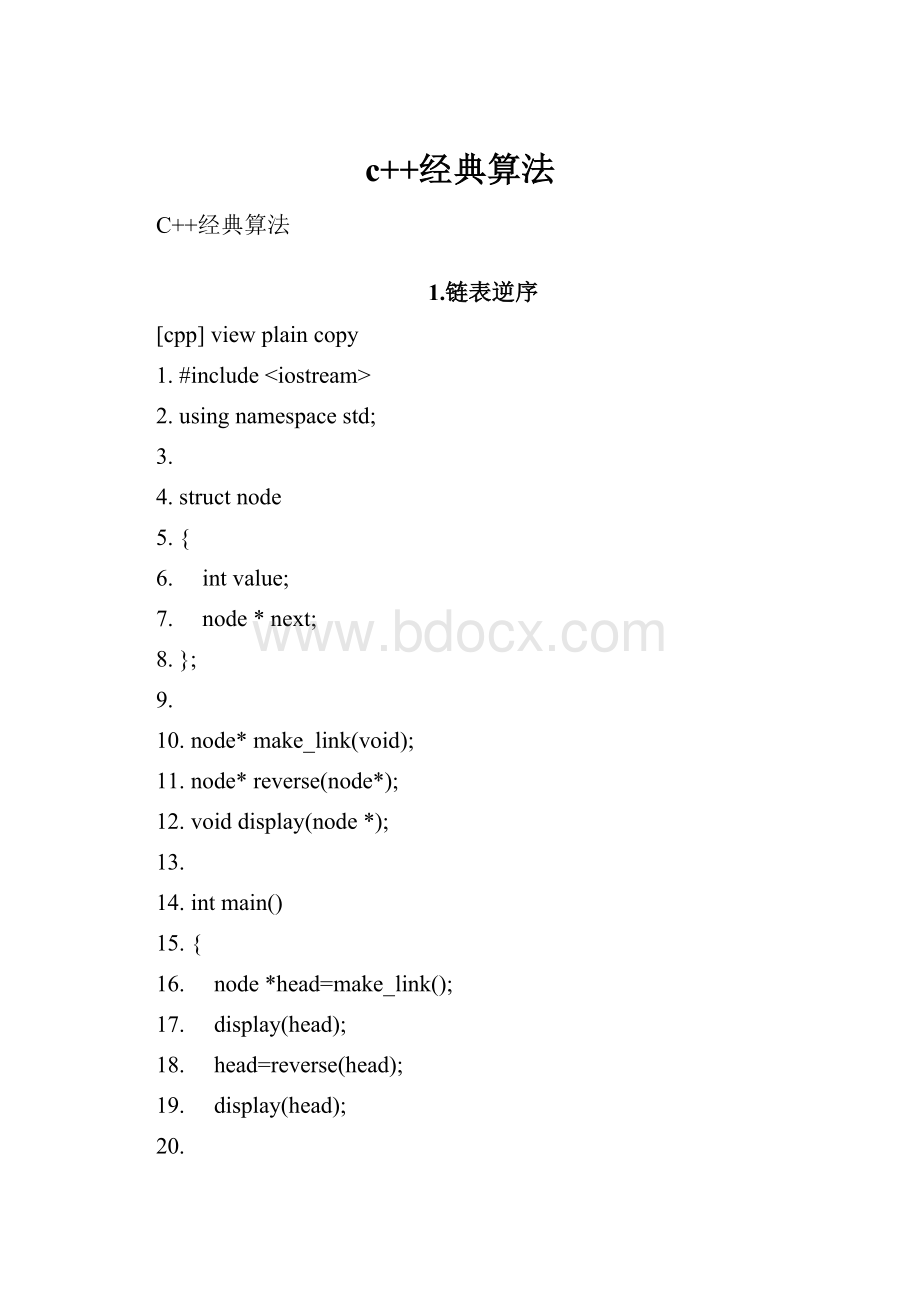c++经典算法.docx
《c++经典算法.docx》由会员分享,可在线阅读,更多相关《c++经典算法.docx(23页珍藏版)》请在冰豆网上搜索。

c++经典算法
C++经典算法
1.链表逆序
[cpp] viewplain copy
1.#include
2.using namespace std;
3.
4.struct node
5.{
6. int value;
7. node * next;
8.};
9.
10.node* make_link(void);
11.node* reverse(node*);
12.void display(node *);
13.
14.int main()
15.{
16. node *head=make_link();
17. display(head);
18. head=reverse(head);
19. display(head);
20.
21. return 0;
22.}
23.
24.node* make_link(void)
25.{
26. node *head=new node();
27. node *cur=head;
28. for(int i=0;i<10;i++)
29. {
30. cur->value=rand()%10;
31. cur->next=new node();
32. cur=cur->next;
33. }
34.
35. return head;
36.}
37.
38.node* reverse(node *head)
39.{
40. node *pre,*post,*cur;
41. if(!
head && !
head->next)
42. return head;
43. pre=head;
44. cur=pre->next;
45. while(cur)
46. {
47. post=cur->next;
48. cur->next=pre;
49. pre=cur;
50. cur=post;
51. }
52. head->next=NULL;
53. return pre;
54.}
55.
56.void display(node * head)
57.{
58. node * cur=head;
59. while(cur)
60. {
61. cout<value<<" ";
62. cur=cur->next;
63. }
64. cout<65.}
2.链表合并
[cpp] viewplain copy
1.#include
2.
3.using namespace std;
4.
5.struct node
6.{
7. int value;
8. node *next;
9.};
10.
11.node *make_list(void);
12.void display(node *);
13.void sort(node *);
14.node *merge(node *,node *);
15.
16.int main()
17.{
18. node *node1=make_list();
19. display(node1);
20. sort(node1);
21.
22. node *node2=make_list();
23. display(node2);
24. sort(node2);
25.
26. node *mnode=merge(node1,node2);
27. display(mnode);
28.
29. return 0;
30.}
31.
32.
33.node *make_list(void)
34.{
35. node *head=new node();
36. node *cur=head;
37. for(int i=0;i<10;i++)
38. {
39. cur->value=rand()%10;
40. cur->next=new node();
41. cur=cur->next;
42. }
43.
44. return head;
45.}
46.
47.void display(node *head)
48.{
49. node *cur=head;
50. while(cur)
51. {
52. cout<value<<" ";
53. cur=cur->next;
54. }
55. cout<56.}
57.
58.
59.void sort(node *head)
60.{
61. node *cur=head;
62. while(cur)
63. {
64. node *min=cur;
65. node *cur2=cur->next;
66. while(cur2)
67. {
68. if(cur2->value < min->value)
69. min=cur2;
70. cur2=cur2->next;
71. }
72.
73. int temp=cur->value;
74. cur->value=min->value;
75. min->value=temp;
76. cur=cur->next;
77. }
78.}
79.
80.node *merge(node *h1,node *h2)
81.{
82. node *mcur=new node();
83. node *cur1=h1;
84. node *cur2=h2;
85. while(cur1&&cur2)
86. {
87. if(cur1->value < cur2->value)
88. {
89. mcur->next=cur1;
90. mcur=mcur->next;
91. cur1=cur1->next;
92. }
93. else
94. {
95. mcur->next=cur2;
96. mcur=mcur->next;
97. cur2=cur2->next;
98. }
99. }
100. if(cur1)
101. mcur->next=cur1;
102. else
103. mcur->next=cur2;
104. return h1->value < h2->value ?
h1:
h2;
105.}
3.一棵树是否某条路径结点之和等于给定值。
并描述算法复杂度
[cpp] viewplain copy
1.#include
2.using namespace std;
3.
4.struct node
5.{
6. int value;
7. node *left;
8. node *right;
9.};
10.
11.node * build_tree(void);
12.bool find(node *,int);
13.
14.int main()
15.{
16. node *tree=build_tree();
17. int t;
18. cout<<"Enter your number:
";
19. cin>>t;
20. cout<21. cout<22.}
23.
24.node *build_tree()
25.{
26. int a;
27. cin>>a;
28. if(a == 0)
29. return NULL;
30. node *root=new node();
31. root->value=a;
32. root->left=build_tree();
33. root->right=build_tree();
34.
35. cout<<"build tree success"<36. return root;
37.}
38.
39.bool find(node *root,int v)
40.{
41. if(!
root)
42. return false;
43. if(root->value == v)
44. return true;
45. else find(root->left,v-root->value) || find(root->right,v-root->value);
46.}
4.你熟悉的排序算法并描述算法复杂度。
快速排序
[cpp] viewplain copy
1.#include
2.using namespace std;
3.
4.int partition(int a[],int low,int high)
5.{
6. int key=a[low]; //用子表的第一个记录作杻轴记录
7. while(low < high) //从表的两端交替地向中间扫描
8. {
9. while(low < high && a[high] >= key)
10. --high;
11. { //将比杻轴记录小的记录交换到低端
12. int temp=a[low];
13. a[low]=a[high];
14. a[high]=temp;
15. }
16.
17. while(low < high && a[low] <= key)
18. ++low;
19. { //将比杻轴记录大的记录交换到低端
20. int temp=a[low];
21. a[low]=a[high];
22. a[high]=temp;
23. }
24. }
25. return low; //返回杻轴所在的位置
26.}
27.
28.void qsort(int a[],int b,int e)
29.{
30. if(b < e)
31. {
32. int m=partition(a,b,e);
33. qsort(a,b,m-1);
34. qsort(a,m+1,e);
35. }
36.}
37.
38.int main()
39.{
40. int a[]={2,3,7,8,3,5};
41. qsort(a,0,5);
42. for(int i=0;i<6;i++)
43. cout<44. cout<45.
46. return 0;
47.}
归并排序
[cpp] viewplain copy
1.#include
2.using namespace std;
3.
4.void display(int a[],int size)
5.{
6. for(int i=0;i7. cout<8. cout<9.}
10.
11.void mmerge(int *a,int low,int middle ,int high )
12.{
13. int fronArray[100],postArray[100];
14. int front=middle-low+1;
15. int post=high-middle;
16. for(int i=0;i17. fronArray[i]=a[low+i];
18.
19. for(int j=0;j20. postArray[j]=a[middle+j+1];
21.
22. fronArray[front]=9999; //哨兵
23. postArray[post]=9999;
24.
25. int i=0,j=0;
26. for(int k=low;k<=high;k++)
27. {
28. if(fronArray[i]29. a[k]=fronArray[i++];
30. else
31. a[k]=postArray[j++];
32. }
33.}
34.
35.void merge_sort(int *a,int low,int high)
36.{
37. if(low38. {
39. int middle=(low+high)/2;
40. merge_sort(a,low,middle);
41. merge_sort(a,middle+1,high);
42. mmerge(a,low,middle,high);
43. }
44.}
45.
46.int main()
47.{
48. int a[]={9,3,5,7,6,8,10,22,21,34};
49. display(a,10);
50. merge_sort(a,0,9);
51. display(a,10);
52.
53. return 0;
54.}
堆排序
[cpp] viewplain copy
1./*
2.堆排序
3.
(1)用大根堆排序的基本思想
4.① 先将初始文件R[1..n]建成一个大根堆,此堆为初始的无序区
5.② 再将关键字最大的记录R[1](即堆顶)和无序区的最后一个记录R[n]交换,
6.由此得到新的无序区R[1..n-1]和有序区R[n],且满足R[1..n-1].keys≤R[n].key
7.③ 由于交换后新的根R[1]可能违反堆性质,故应将当前无序区R[1..n-1]调整为堆。
8.然后再次将R[1..n-1]中关键字最大的记录R[1]和该区间的最后一个记录R[n-1]交换,
9.由此得到新的无序区R[1..n-2]和有序区R[n-1..n],且仍满足关系R[1..n- 2].keys≤R[n-1..n].keys,
10.同样要将R[1..n-2]调整为堆。
11.……
12.直到无序区只有一个元素为止。
13.
(2)大根堆排序算法的基本操作:
14.① 初始化操作:
将R[1..n]构造为初始堆;
15.② 每一趟排序的基本操作:
将当前无序区的堆顶记录R[1]和该区间的最后一个记录交换,然后将新的无序区调整为堆(亦称重建堆)。
16.注意:
17.①只需做n-1趟排序,选出较大的n-1个关键字即可以使得文件递增有序。
18.②用小根堆排序与利用大根堆类似,只不过其排序结果是递减有序的。
19.堆排序和直接选择排序相反:
在任何时刻,堆排序中无序区总是在有序区之前,
20.且有序区是在原向量的尾部由后往前逐步扩大至整个向量为止。
21.*/
22.
23.#include
24.
25.using namespace std;
26.
27.//生成大根堆
28.void HeapAdjust(int SortData[],int StartIndex, int Length)
29.{
30. while(2*StartIndex+1 < Length)
31. {
32. int MaxChildrenIndex = 2*StartIndex+1 ;
33. if(2*StartIndex+2 < Length )
34. {
35. //比较左子树和右子树,记录最大值的Index
36. if(SortData[2*StartIndex+1]37. {
38. MaxChildrenIndex = 2*StartIndex+2;
39. }
40. }
41. if(SortData[StartIndex] < SortData[MaxChildrenIndex])
42. {
43. //交换i与MinChildrenIndex的数据
44. int tmpData =SortData[StartIndex];
45. SortData[StartIndex] =SortData[MaxChildrenIndex];
46. SortData[MaxChildrenIndex] =tmpData;
47. //堆被破坏,需要重新调整
48. StartIndex = MaxChildrenIndex ;
49. }
50. else
51. {
52. //比较左右孩子均大则堆未破坏,不再需要调整
53. break;
54. }
55. }
56.}
57.
58.//堆排序
59.void HeapSortData(int SortData[], int Length)
60.{
61. int i=0;
62.
63. //将Hr[0,Length-1]建成大根堆
64. for (i=Length/2-1; i>=0; i--)
65. {
66. HeapAdjust(SortData, i, Length);
67. }
68.
69. for (i=Length-1; i>0; i--)
70. {
71. //与最后一个记录交换
72. int tmpData =SortData[0];
73. SortData[0] =SortData[i];
74. SortData[i] =tmpData;
75. //将H.r[0..i]重新调整为大根堆
76. HeapAdjust(Sort